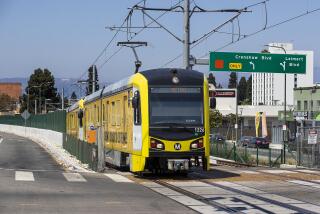Use of Explosives for Tunnel Could Be Cut
In an effort to mollify residents in the Hollywood Hills, Los Angeles County Supervisor Zev Yaroslavsky said Monday that explosives are not needed to dig most of the tunnel for the Red Line subway.
The issue of tunneling under the homes of residents in the area has created widespread opposition among homeowners in the Santa Monica Mountains. Many have refused to sell subsurface rights to the Metropolitan Transportation Agency, which hopes to finish the $1.3-billion project linking the San Fernando Valley with the rest of the city by 2001.
Yaroslavsky, who is an MTA board member, said his conclusion that blasting can be limited is based on the report of a panel of tunneling experts that is scheduled to be released Wednesday.
“It is now clear that it is not necessary to use explosives to the extent the Metropolitan Transit Agency had proposed, that it is possible to avoid blasting under canyon homes,” Yaroslavsky said. “This is a major change that should be reassuring to the residents of the Hollywood Hills.”
Instead, tunneling machines will do most of the work, he said.
Still, because the earth underneath a portion of Solar Drive near Runyon Canyon Park is composed of granite, Yaroslavsky said the use of some explosives will be necessary. But he pledged that blasts would not be felt by residents because the MTA would limit the intensity of the explosions.
Yaroslavsky also proposed:
* Using grouting to keep water from leaking into tunnels, which would help keep ground water levels in the area relatively consistent.
* Monitoring vegetation by botanists in the park and on private property to further ensure that ground-water levels have not slipped too far.
* Limiting hours of work to 7 a.m. to 7 p.m. on weekdays, instead of 7 a.m. to 10 p.m. six days a week.
* Cutting by one-half the total number of explosions required for the entire project.
* Assigning a full-time ombudsman to resolve complaints.
The changes would require approval by the full MTA board, and would add two to three months of time to the project, Yaroslavsky said. It would also add about $5 million in costs.
“These are extraordinary steps that are being taken,” Yaroslavsky said. “But it is a price worth paying to reassure residents of the area and park goers.”
On Monday, attorney Kevin Brogan, who represents about a dozen of the area’s residents, said Yaroslavsky’s plan might console some residents, but not others, who are not happy with the $2,000 being offered by the MTA for tunneling rights.
“There are some owners who are concerned about the dynamiting and some who don’t care as much,” said Brogan. “From an overall environmental viewpoint, the people up there should be pleased there wouldn’t be demolition by explosion.”
MTA spokeswoman Andrea Greene said Monday that MTA staff backed Yaroslavsky’s ideas.
On Monday, MTA Board Chairman Larry Zarian said he would also probably be supportive.
“If we can tunnel with the least amount of inconvenience to the residents and if the cost is relatively modest, that is fine,” he said.
The final decision rests with the MTA board, though Yaroslavsky said Monday that if his colleagues do not agree to his conditions, he would not support completing the project.
“I need to be sure that [the tunneling] is safe and unobtrusive,” Yaroslavsky said. “If I can’t be satisfied, I can’t ask them to be satisfied.”
Yaroslavsky’s motion will be introduced Wednesday, which is also the day the board is scheduled to decide whether to move ahead with the process of condemnation. That process would allow the MTA to obtain tunneling rights from property owners without their expressed agreement.
So far, only 24 property owners out of 72 have agreed to the easements offered by the MTA, Greene said. Those numbers do not include homes inside the park.
Each day of delay would cost about $90,000.
More to Read
Sign up for Essential California
The most important California stories and recommendations in your inbox every morning.
You may occasionally receive promotional content from the Los Angeles Times.










